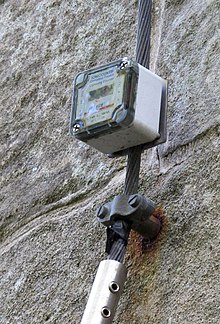Lightning counter
A lightning counter , English Lightning Strike Counter (LSC) , is a special counter which registers lightning strikes in a lightning protection system , usually in the area of the lightning rod , and automatically counts these events for the purpose of obtaining information. Lightning counters are used, among other things, to ensure and document the functionality of lightning protection in existing lightning protection systems on buildings. Another application is in the field of meteorology to precisely record the lightning strikes per unit of time on certain exposed buildings or structures such as transmission masts for research purposes. Lightning counters are among the optional components of a lightning protection system and are specified in the requirements of the International Electrotechnical Commission (IEC) in the standard IEC 62561-6 .
functionality
Lightning counters are usually attached outside directly to the down conductor system, i.e. between the interception system and the lightning protection earth . The lightning counter records the increase in the magnetic flux density , which is caused by the sudden lightning current in the lightning rod, and adds up (counts) these events. A coil is used for detection in which the lightning strike generates a proportional current pulse of reduced strength. For this purpose, the lightning counter is mounted directly on the metallic lightning rod (metal rod) through which the lightning current is diverted to earth, as shown in the adjacent picture. Depending on the model, the counter can be implemented as an electromechanical or electronic counter and can include various additional functions, such as, for example, intermediate storage or automatic determination of the lightning strikes per unit of time.
In order to avoid incorrect counting, for example due to other currents flowing through the earth electrode, lightning counters must be designed so that they only record the current pulses generated by lightning strikes. This is done by filters in the lightning counter, which separates signals with short rise times in the range of a few microseconds , as is typical for lightning strikes, from other interfering signals. Furthermore, lightning counters work with certain triggering thresholds and only record electrical currents in the down-conductor system that have a peak value of more than 1 kA (special case from 100 A).
Individual evidence
- ↑ a b IEC 62561-6: 2018 Lightning protection system components (LPSC) - Part 6: Requirements for lightning strike counters (LSC). International Electrotechnical Commission (IEC), 2018, accessed September 20, 2019 .
